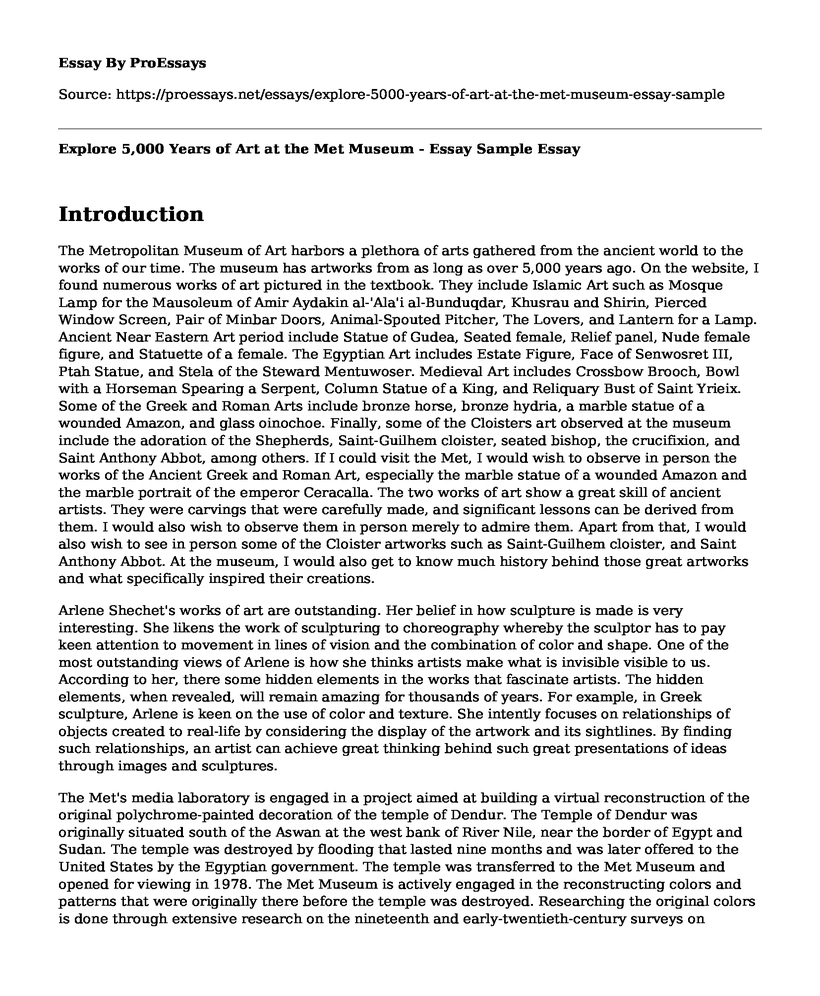Introduction
The Metropolitan Museum of Art harbors a plethora of arts gathered from the ancient world to the works of our time. The museum has artworks from as long as over 5,000 years ago. On the website, I found numerous works of art pictured in the textbook. They include Islamic Art such as Mosque Lamp for the Mausoleum of Amir Aydakin al-'Ala'i al-Bunduqdar, Khusrau and Shirin, Pierced Window Screen, Pair of Minbar Doors, Animal-Spouted Pitcher, The Lovers, and Lantern for a Lamp. Ancient Near Eastern Art period include Statue of Gudea, Seated female, Relief panel, Nude female figure, and Statuette of a female. The Egyptian Art includes Estate Figure, Face of Senwosret III, Ptah Statue, and Stela of the Steward Mentuwoser. Medieval Art includes Crossbow Brooch, Bowl with a Horseman Spearing a Serpent, Column Statue of a King, and Reliquary Bust of Saint Yrieix. Some of the Greek and Roman Arts include bronze horse, bronze hydria, a marble statue of a wounded Amazon, and glass oinochoe. Finally, some of the Cloisters art observed at the museum include the adoration of the Shepherds, Saint-Guilhem cloister, seated bishop, the crucifixion, and Saint Anthony Abbot, among others. If I could visit the Met, I would wish to observe in person the works of the Ancient Greek and Roman Art, especially the marble statue of a wounded Amazon and the marble portrait of the emperor Ceracalla. The two works of art show a great skill of ancient artists. They were carvings that were carefully made, and significant lessons can be derived from them. I would also wish to observe them in person merely to admire them. Apart from that, I would also wish to see in person some of the Cloister artworks such as Saint-Guilhem cloister, and Saint Anthony Abbot. At the museum, I would also get to know much history behind those great artworks and what specifically inspired their creations.
Arlene Shechet's works of art are outstanding. Her belief in how sculpture is made is very interesting. She likens the work of sculpturing to choreography whereby the sculptor has to pay keen attention to movement in lines of vision and the combination of color and shape. One of the most outstanding views of Arlene is how she thinks artists make what is invisible visible to us. According to her, there some hidden elements in the works that fascinate artists. The hidden elements, when revealed, will remain amazing for thousands of years. For example, in Greek sculpture, Arlene is keen on the use of color and texture. She intently focuses on relationships of objects created to real-life by considering the display of the artwork and its sightlines. By finding such relationships, an artist can achieve great thinking behind such great presentations of ideas through images and sculptures.
The Met's media laboratory is engaged in a project aimed at building a virtual reconstruction of the original polychrome-painted decoration of the temple of Dendur. The Temple of Dendur was originally situated south of the Aswan at the west bank of River Nile, near the border of Egypt and Sudan. The temple was destroyed by flooding that lasted nine months and was later offered to the United States by the Egyptian government. The temple was transferred to the Met Museum and opened for viewing in 1978. The Met Museum is actively engaged in the reconstructing colors and patterns that were originally there before the temple was destroyed. Researching the original colors is done through extensive research on the nineteenth and early-twentieth-century surveys on observations of other temples to help predict the patterns and colors of the Dendur temple. The process also involves trying to reconstruct color and patterns through determining the remnants of the scene, both with the naked eye and through digital imaging technique called visible-induced luminescence (VIL) imaging.
The Heilbrunn Timeline of Art History comprises essays, artworks, and the chronologies that give details of art and global culture gathered and preserved at the Met Museum's collection. The timeline is very significant to students studying art history in various ways. First, it provides essays that give history about ancient works of art so that a student can learn the historical background of each work of art. Second, the timeline avails all works of art collected from all over the world, making it easy for a student studying art history to view them at just one point. And lastly, the timeline also gives chronologies from the earliest times to the present, making it easy to classify works of arts-based on the period of their creation.
Reference
The Metropolitan Museum of Art. http://www.metmuseum.org/
Cite this page
Explore 5,000 Years of Art at the Met Museum - Essay Sample. (2023, Aug 28). Retrieved from https://proessays.net/essays/explore-5000-years-of-art-at-the-met-museum-essay-sample
If you are the original author of this essay and no longer wish to have it published on the ProEssays website, please click below to request its removal:
- Influence of Classroom Environment and Family Environment on Students' Potential and Performance in the Chinese Society
- Hate Groups and Extremism Essay Example
- Issues of Identity Essay Example
- Paper Example on Rachel Dolezal's Identity and Culture
- Essay Example on Self-Absorption: Detaching From Foreign Culture?
- Essay on Black & White in America: The Ongoing Divide
- Essay Sample on Marco's Father Making Decisions: Dilemma for Marco







